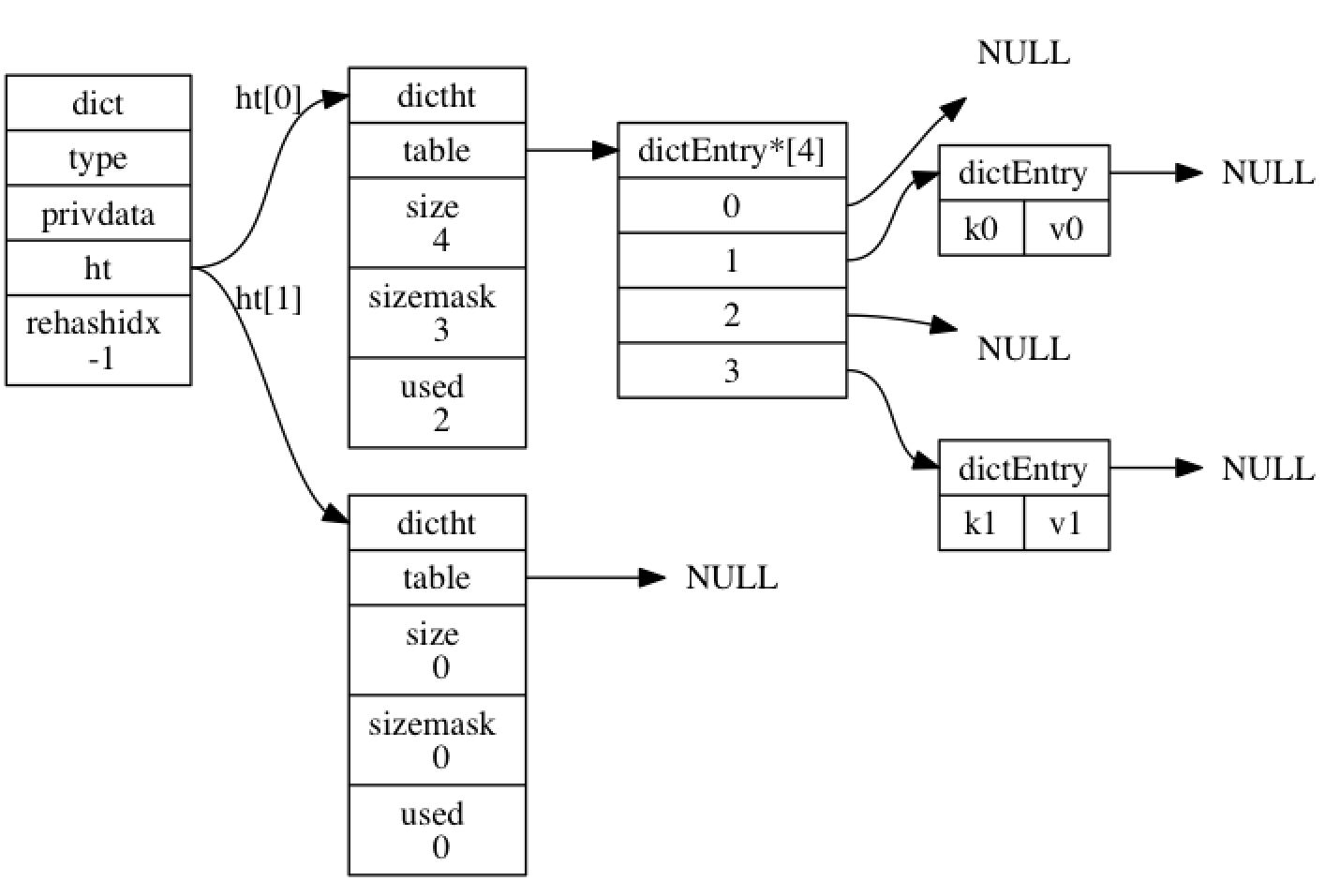Redis源码剖析-Dict字典
目录
改换一下策略,不直接介绍源码,打算先整体介绍一下思路,然后再根据源码解释具体的实现。

如图所示,一个dict字典中由两个hashtable组成,分别为ht[0]和ht[1],用到的基本上都是ht[0]。 那么ht[1]什么时候用到呢?因为hash算出来的索引值是有可能重复的,也就是说不同的dictEntry有可能位于同一个hashtable的槽内,如果拥有的dictEntry的数量和slot的数量的比值超过了5,相当于平均每个slot拥有5个以上的dictEntry的时候,就需要重新rehash整个dict。
扩展或者收缩dict的时候,并不是一次性完成的, 因为如果dict中拥有大量数据的时候,一次性的操作有可能会影响正式的服务。
所以redis采取的策略是分布式的rehash。 利用rehashidx来记录当前进行到了哪个索引,下一次的rehash从这个索引开始。那什么时候进行rehash呢,有两种策略, 一种是在指定时间内执行固定步数;另一种是在每次对当前dict进行查询、修改的时候,每一次操作都附带完成一个索引值的rehash。这样就把整体的rehash时间平摊到了各个小操作中。
在rehash的过程中,如果执行查询操作,两个ht都需要查询;修改和删除也需要操作两个ht,插入的时候,只需要插入到ht[1],这样就保证了ht[0]里边的键值对只少不多。
Dict定义
typedef struct dict {
dictType *type; // 类型特定函数
void *privdata; // 私有数据
dictht ht[2]; // 2个哈希表
// rehash 索引
// 当 rehash 不在进行时,值为 -1
long rehashidx; /* rehashing not in progress if rehashidx == -1 */
// 目前正在运行的安全迭代器的数量
unsigned long iterators; /* number of iterators currently running */
} dict;
dictType保存一些用于操作特定类型键值对的函数,定义如下:
typedef struct dictType {
// 计算哈希值的函数
uint64_t (*hashFunction)(const void *key);
// 复制键的函数
void *(*keyDup)(void *privdata, const void *key);
// 复制值的函数
void *(*valDup)(void *privdata, const void *obj);
// 比较键的函数
int (*keyCompare)(void *privdata, const void *key1, const void *key2);
// 销毁键的函数
void (*keyDestructor)(void *privdata, void *key);
// 销毁值的函数
void (*valDestructor)(void *privdata, void *obj);
} dictType;
dicht哈希表,所有的键值对保存在里边,定义如下:
typedef struct dictht {
dictEntry **table; // 哈希数组
unsigned long size; // 总的哈希表大小
// 哈希表大小掩码,用于计算索引值
// 总是等于 size - 1
unsigned long sizemask;
unsigned long used; // 该哈希表已有节点的数量
} dictht;
dictEntry则保存了每一个具体的键值对,定义如下:
typedef struct dictEntry {
// 键
void *key;
union {
void *val;
uint64_t u64;
int64_t s64;
double d;
} v; // 值
// 指向下一个结点,因为hash值有可能冲突,冲突的时候链表形式保存在同一个索引后边
struct dictEntry *next;
} dictEntry;
Dict操作
判断是否需要进行rehash
/* Resize the table to the minimal size that contains all the elements,
* but with the invariant of a USED/BUCKETS ratio near to <= 1 */
int dictResize(dict *d)
{
int minimal;
// 不能在关闭 rehash 或者正在 rehash 的时候调用
if (!dict_can_resize || dictIsRehashing(d)) return DICT_ERR;
// 查看已经使用了多少结点,最少分配DICT_HT_INITIAL_SIZE=4个结点
// 否则,计算让比率接近 1:1 所需要的最少节点数量
minimal = d->ht[0].used;
if (minimal < DICT_HT_INITIAL_SIZE)
minimal = DICT_HT_INITIAL_SIZE;
return dictExpand(d, minimal);
}
/* Expand or create the hash table */
/*
* 创建一个新的哈希表,并根据字典的情况,选择以下其中一个动作来进行:
*
* 1) 如果字典的 0 号哈希表为空,那么将新哈希表设置为 0 号哈希表
* 2) 如果字典的 0 号哈希表非空,那么将新哈希表设置为 1 号哈希表,
* 并打开字典的 rehash 标识,使得程序可以开始对字典进行 rehash
*
* size 参数不够大,或者 rehash 已经在进行时,返回 DICT_ERR 。
*
* 成功创建 0 号哈希表,或者 1 号哈希表时,返回 DICT_OK 。
*/
int dictExpand(dict *d, unsigned long size)
{
dictht n; /* the new hash table */
// 计算大于size的第一个2的N次方的值,用来当作新的哈希表的大小
unsigned long realsize = _dictNextPower(size);
/* the size is invalid if it is smaller than the number of
* elements already inside the hash table */
if (dictIsRehashing(d) || d->ht[0].used > size)
return DICT_ERR;
/* Rehashing to the same table size is not useful. */
// 如果新表大小跟老表一样, 没有进行expand的需要
if (realsize == d->ht[0].size) return DICT_ERR;
/* Allocate the new hash table and initialize all pointers to NULL */
n.size = realsize;
n.sizemask = realsize-1;
n.table = zcalloc(realsize*sizeof(dictEntry*));
n.used = 0;
/* Is this the first initialization? If so it's not really a rehashing
* we just set the first hash table so that it can accept keys. */
// 如果 0 号哈希表为空,那么这是一次初始化:
// 程序将新哈希表赋给 0 号哈希表的指针,然后字典就可以开始处理键值对了。
if (d->ht[0].table == NULL) {
d->ht[0] = n;
return DICT_OK;
}
/* Prepare a second hash table for incremental rehashing */
// 如果 0 号哈希表非空,那么这是一次 rehash :
// 程序将新哈希表设置为 1 号哈希表,
// 并将字典的 rehash 标识打开,让程序可以开始对字典进行 rehash
d->ht[1] = n;
d->rehashidx = 0;
return DICT_OK;
}
rehash算法
/* Performs N steps of incremental rehashing. Returns 1 if there are still
* keys to move from the old to the new hash table, otherwise 0 is returned.
* 执行 N 步渐进式 rehash 。
*
* 返回 1 表示仍有键需要从 0 号哈希表移动到 1 号哈希表,
* 返回 0 则表示所有键都已经迁移完毕。
* Note that a rehashing step consists in moving a bucket (that may have more
* than one key as we use chaining) from the old to the new hash table, however
* since part of the hash table may be composed of empty spaces, it is not
* guaranteed that this function will rehash even a single bucket, since it
* will visit at max N*10 empty buckets in total, otherwise the amount of
* work it does would be unbound and the function may block for a long time.
* 每步 rehash 都是以一个哈希表索引(桶)作为单位的,
* 一个桶里可能会有多个节点,
* 被 rehash 的桶里的所有节点都会被移动到新哈希表。*/
int dictRehash(dict *d, int n) {
// 由于hash表中的桶有可能为空,设置最大访问空桶的数量为n*10,否则如果空桶很多的话会等待比较长的一段时间
int empty_visits = n*10; /* Max number of empty buckets to visit. */
// 只可以在 rehash 进行中时执行
if (!dictIsRehashing(d)) return 0;
while(n-- && d->ht[0].used != 0) {
dictEntry *de, *nextde;
/* Note that rehashidx can't overflow as we are sure there are more
* elements because ht[0].used != 0 */
// 确保 rehashidx 没有越界
assert(d->ht[0].size > (unsigned long)d->rehashidx);
// 略过数组中为空的索引,找到下一个非空索引
// 如果访问的空索引达到了n*10, 停止遍历
while(d->ht[0].table[d->rehashidx] == NULL) {
d->rehashidx++;
if (--empty_visits == 0) return 1;
}
// 指向该索引的链表表头节点
de = d->ht[0].table[d->rehashidx];
/* Move all the keys in this bucket from the old to the new hash HT */
// 将链表中的所有节点迁移到新哈希表
while(de) {
unsigned int h;
nextde = de->next;
/* Get the index in the new hash table */
// 根据新表的sizemask计算哈希值
h = dictHashKey(d, de->key) & d->ht[1].sizemask;
// 插入节点到新哈希表
de->next = d->ht[1].table[h];
d->ht[1].table[h] = de;
// 更新计数器
d->ht[0].used--;
d->ht[1].used++;
de = nextde;
}
// 将刚迁移完的哈希表索引的指针设为空
d->ht[0].table[d->rehashidx] = NULL;
// 更新 rehash 索引
d->rehashidx++;
}
/* Check if we already rehashed the whole table... */
// 如果 0 号哈希表为空,那么表示 rehash 执行完毕
if (d->ht[0].used == 0) {
// 释放 0 号哈希表
zfree(d->ht[0].table);
// 将原来的 1 号哈希表设置为新的 0 号哈希表
d->ht[0] = d->ht[1];
// 重置旧的 1 号哈希表
_dictReset(&d->ht[1]);
// 关闭 rehash 标识
d->rehashidx = -1;
return 0;
}
/* More to rehash... */
return 1;
}
在两种情况下会调用rehash的操作,一种是在指定时间内执行操作,每次操作进行100步:
/* Rehash for an amount of time between ms milliseconds and ms+1 milliseconds */
int dictRehashMilliseconds(dict *d, int ms) {
// 记录开始时间
long long start = timeInMilliseconds();
int rehashes = 0;
while(dictRehash(d,100)) {
// 在给定毫秒数内,以 100 步为单位,对字典进行 rehash
rehashes += 100;
// 如果时间已过,跳出
if (timeInMilliseconds()-start > ms) break;
}
return rehashes;
}
另一种是在执行普通的查询或者更新操作的时候,同时执行一次rehash
/* This function is called by common lookup or update operations in the
* dictionary so that the hash table automatically migrates from H1 to H2
* while it is actively used. */
static void _dictRehashStep(dict *d) {
if (d->iterators == 0) dictRehash(d,1);
}
Dict插入键
/* Add an element to the target hash table */
int dictAdd(dict *d, void *key, void *val)
{
// 往字典中添加一个key
dictEntry *entry = dictAddRaw(d,key,NULL);
if (!entry) return DICT_ERR;
// 如果成功返回, 为key是指value
dictSetVal(d, entry, val);
return DICT_OK;
}
dictEntry *dictAddRaw(dict *d, void *key, dictEntry **existing)
{
int index;
dictEntry *entry;
dictht *ht;
// 如果在进行rehash操作, 执行一步rehash
if (dictIsRehashing(d)) _dictRehashStep(d);
/* Get the index of the new element, or -1 if
* the element already exists. */
// 获取key的索引,如果索引已经存在,返回NULL
if ((index = _dictKeyIndex(d, key, dictHashKey(d,key), existing)) == -1)
return NULL;
/* Allocate the memory and store the new entry.
* Insert the element in top, with the assumption that in a database
* system it is more likely that recently added entries are accessed
* more frequently. */
// 是否在进行rehash操作,如果在rehash, 放到新表ht[1], 否则放到ht[0]
ht = dictIsRehashing(d) ? &d->ht[1] : &d->ht[0];
entry = zmalloc(sizeof(*entry));
// 插入新结点
entry->next = ht->table[index];
ht->table[index] = entry;
ht->used++;
/* Set the hash entry fields. */
dictSetKey(d, entry, key);
return entry;
}
添加或更新元素
- 如果之前元素不存在,添加成功后返回1
- 如果之前元素存在,更新元素,同时返回0
- 如果存在的话,设置新的值,然后释放老的值,这样做能够充分利用引用计数,如果是同一个元素的话,更改计数就行
int dictReplace(dict *d, void *key, void *val)
{
dictEntry *entry, *existing, auxentry;
/* Try to add the element. If the key
* does not exists dictAdd will suceed. */
// 添加键值对,如果之前不存在的话,添加成功返回1
entry = dictAddRaw(d,key,&existing);
if (entry) {
dictSetVal(d, entry, val);
return 1;
}
/* Set the new value and free the old one. Note that it is important
* to do that in this order, as the value may just be exactly the same
* as the previous one. In this context, think to reference counting,
* you want to increment (set), and then decrement (free), and not the
* reverse. */
// 如果存在的话,设置新的值,然后释放老的值,这样做能够充分利用引用计数,如果是同一个元素的话,更改计数就行
auxentry = *existing;
dictSetVal(d, existing, val);
dictFreeVal(d, &auxentry);
return 0;
}
删除键值对
static dictEntry *dictGenericDelete(dict *d, const void *key, int nofree) {
unsigned int h, idx;
dictEntry *he, *prevHe;
int table;
// 如果两个哈希表都没有元素, 返回NULL
if (d->ht[0].used == 0 && d->ht[1].used == 0) return NULL;
// 如果正在进行rehash,先执行一步rehash
if (dictIsRehashing(d)) _dictRehashStep(d);
h = dictHashKey(d, key);
// 两个表都要查看
for (table = 0; table <= 1; table++) {
idx = h & d->ht[table].sizemask;
he = d->ht[table].table[idx];
prevHe = NULL;
while(he) {
if (key==he->key || dictCompareKeys(d, key, he->key)) {
/* Unlink the element from the list */
if (prevHe)
prevHe->next = he->next;
else
d->ht[table].table[idx] = he->next;
if (!nofree) {
dictFreeKey(d, he);
dictFreeVal(d, he);
zfree(he);
}
d->ht[table].used--;
return he;
}
prevHe = he;
he = he->next;
}
// 如果没有在进行rehash,说明ht[1]没有值,就不用查看了
if (!dictIsRehashing(d)) break;
}
return NULL; /* not found */
}
参数中的nofree用来标记是否真的删除,如果这个值为1的话,只是把这个键值对从table中拿下来,但并不是真的删除;如果想要移除一个键值对,但是在真的删除之前还想使用它的值,这个操作是有用的。
如果没有这个操作,需要先执行find操作找到结点,使用之后再执行删除,就需要进行两次查找;而这个操作只需要进行一次查找,用完之后再调用dictFreeUnlinkedEntry释放这个键值对就行。
查看key的值
dictEntry *dictFind(dict *d, const void *key)
{
dictEntry *he;
unsigned int h, idx, table;
// 如果没有键值对,返回NULL
if (d->ht[0].used + d->ht[1].used == 0) return NULL; /* dict is empty */
// 如果正在进行rehash,先进行一次rehash
if (dictIsRehashing(d)) _dictRehashStep(d);
// 计算hash值
h = dictHashKey(d, key);
for (table = 0; table <= 1; table++) {
// 计算索引值
idx = h & d->ht[table].sizemask;
he = d->ht[table].table[idx];
while(he) {
if (key==he->key || dictCompareKeys(d, key, he->key))
return he;
he = he->next;
}
// 如果没有在进行rehash,没有查看ht[1]的必要
if (!dictIsRehashing(d)) return NULL;
}
return NULL;
}
void *dictFetchValue(dict *d, const void *key) {
dictEntry *he;
he = dictFind(d,key);
return he ? dictGetVal(he) : NULL;
}
此外还有一个遍历dict的操作,如果dict保持不变,直接按照索引顺序遍历就行,但是由于dict存在扩大和缩小的可能性,如果和做到在扩大或缩小的同时,遍历dict能够不漏掉所有键值对呢,这个算法比较复杂, 单独开一篇研究。

